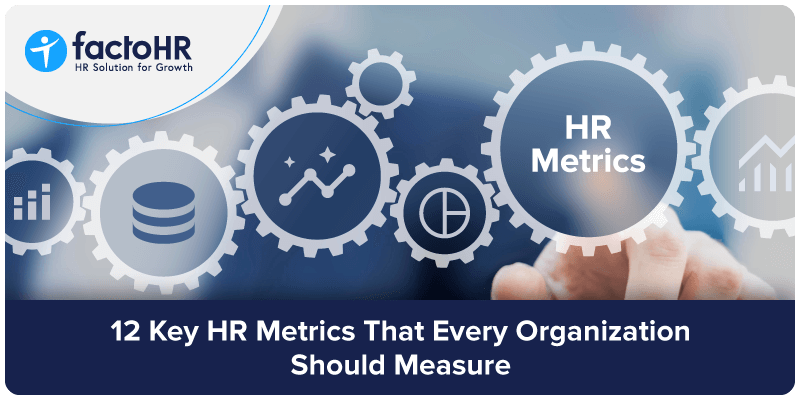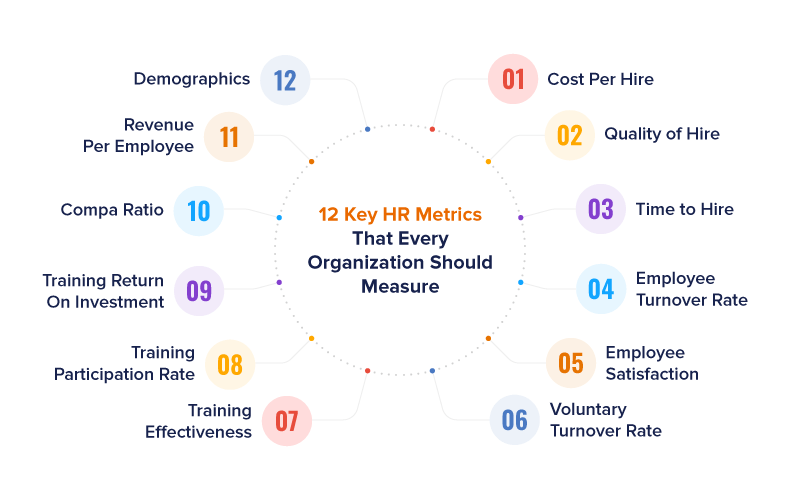12 Critical HR Metrics Every Business Must Track in 2025

Table of Contents
The end goal of any organization is to improve and grow constantly. This growth is not just limited to finances; it also includes employee satisfaction and engagement and new ideas that drive a way toward positive change. Streamlining HR operations with the help of automation can help businesses thrive, and that is where HR metrics can be helpful.
HR metrics basically enhance the power of data-driven HR decision-making. Keeping track of these metrics can help companies identify pitfalls and simplify complex information. Getting an overview of this data eventually streamlines several HR processes, leading to organizational success. In this comprehensive blog, we will understand 12 HR metrics that are useful for organizations of all sizes.

What are HR Metrics?
One of the most vital roles of HR teams is to keep implementing programs that improve the overall organizational performance. However, the task does not end there because these initiatives need monitoring, and it is also important to measure their effectiveness. HR metrics help in accomplishing this.
HR metrics are tangible quantifications that assist a business in improving the way it manages its human capital. They track the functioning of all HR initiatives and identify the bottlenecks that will eventually help make data-driven decisions in the future.
Earlier HR metrics covered only essential areas like recruitment, retention, and performance management. Over time, they also included training and development, turnover rate, and diversity and inclusion.
Why do HR Metrics Matter?
HR metrics matter because they provide factual data about the workforce. By using the metrics, HR can identify areas where the organization can boost productivity and quickly assess the performance of different teams to ensure it aligns with business strategy and HR goals.
How to Use Human Resource Metrics Effectively?
To use Human Resource metrics effectively, you must set your organizational goals, align HR metrics with those goals, analyze current trends, and use insights to make informed decisions about hiring, employee development, and overall workforce strategy.

Which HR Metric to Measure?
The constantly updating HR analytics and metrics trends have led to a greater emphasis on a data-driven approach. Human resource metrics measure organizational strategies, such as turnover rate and workforce diversity, that track the effectiveness of HR initiatives. Let’s discuss the HR metrics that are very important for the organization.

Cost Per Hire
Cost Per Hire is one of the most critical recruiting metrics that helps to determine how much money is spent on each new hire. The metrics accurately determine how healthy a recruiting strategy is. The formula is given below; you can calculate as per this,
(Total internal recruiting costs + Total external recruiting costs) / Number of hires = Cost per hire
Absenteeism
This metric measures how often employees are absent from work. You can get a detailed view of absence rates per manager or department. You can analyze department—and manager-wise absenteeism, allowing leadership to address absences.
To calculate the Absenteeism metric, follow the below formula:
Absent Rate Per Department = (Total Number of Days Missed by Department / Total Number of Workdays in a Department) x 100
Time Tracking Metrics
These HR metrics help track and analyze the time it takes to complete each task or project. Using these metrics, you can evaluate performance and measure productivity. Using the metrics, you can identify areas for improvement, generate accurate salaries and invoices, and monitor productivity status and attendance rates.
The formula for the time tracking metrics:
(End Time – Start Time) * 24
Recruitment Metrics
Recruitment metrics help improve hiring strategy. You can measure cost per hire, quality of hire, offer acceptance rate, application completion rate, etc. These metrics help attract the best talent, improve productivity, and optimize hiring. They measure your overall recruitment method.
Turnover Rate
These metrics identify the employee turnover rate in a specific time period. You can measure involuntary turnover, voluntary turnover, turnover cost, and average employee tenure. Employee turnover is costly because, on average, an employee takes 6 to 12 months to fully prepare to reach their ‘Optimum Productivity Level.’ The Employee Turnover Ratio is calculated by dividing the number of employees left by the average number of employees during that period.
Headcount
Headcount is a simple but important metric that measures the number of employees who work at an organization at a specific time. The metric includes part-time, full-time, and contract workers. Headcount helps with workforce planning, compliance, budgeting, and retention. A strong handle on your headcount metrics enables you to plan for your specific stage of development.
Diversity Metrics
Diversity metrics help you analyze workforce demographic data to determine improvements, such as department-wise gender imbalance, age group, employee turnover rate, etc. In short, they will give a comprehensive snapshot of the workforce so HR can gain insights related to DEI initiatives. Diversity metrics improve turnover, retention, employee satisfaction, and engagement.
Employee Retention Metrics
The metrics’ key benefit is identifying potential reasons for lowering a company’s retention rate. They can also help you understand workforce stability, which means how many employees remain in the organization over a specific period. If your retention rate is around 90% or higher, it’s a reasonable retention rate.
The formula for retention metrics:
Retention rate = (Number of employees at the end of a period) / (Number of employees at the start of a period) x 100
Voluntary Turnover Rate
The voluntary turnover rate is the percentage of employees who leave the company based on their decisions. Voluntary turnover happens due to higher pay, better work schedules, more benefits, or good HR policy. If your organization’s voluntary turnover rate is high, you must change how employees are treated.
Employee Satisfaction
You can measure employee satisfaction using surveys. Employee satisfaction plays a significant role in any organization. A company’s productivity depends on employee satisfaction. Many studies have shown that happy, engaged, and satisfied employees can help reduce turnover rates.
HR Service and Software Metrics
HR service and software metrics generally measure the efficiency and effectiveness of human resource management. To track the success of HR service and software, you can use these metrics: time to hire, cost per hire, employee satisfaction, employee turnover, retention, and absenteeism.
Training and Development Metrics
Appropriate training and development deliver valuable productivity to the organization. Training and development metrics show training completion rate, training costs, and learner satisfaction. A low training completion rate indicates that training is not delivered well, so more options, like videos, FAQs, etc., must be added to the training.
Formula to calculate the metric:
Training cost per employee = Money spent on training / Participating employees in the training.
Compensation
Compensation metrics analyze, measure, and determine the efficacy of your compensation process. These matrices reveal the success and problem areas of the pay distribution. Compensation metrics provide pay equity and improve productivity. The most helpful compensation metrics are minimum, maximum, midpoint pay range, total cost of workforce, salary differential, salary band metrics, and pay grade inflation.
Workforce Planning
Workforce planning metrics collect workforce information and then track and analyze team performance. This HR metric is often measured through surveys and questionnaires about various aspects of the job and workplace, including management effectiveness, work-life balance, and job security. Workforce planning helps attract new talent to your team and provides sustainable paths to achieving growth goals.
HR Metrics vs. HR Analytics: What is the Difference?
HR metrics are distinctive indicators that allow businesses to quantify various business processes and changes regarding performance and productivity. They determine the overall efficiency and success of HR programs in an organization. They are ideally the bridge between common HR practices and the effect they have on the organization. HR metrics assist businesses in gaining an edge over their competitors while also sustaining steady growth.
On the other hand, HR analytics is the process of gathering and analyzing HR data to identify and overcome challenges that hinder workforce performance. The aim is to provide the company with continuous feedback on whether the HR initiatives are fruitful to the collective operational goals. This concept is used to develop refreshing and predictive insights. The results can be measured by linking HR and survey data with the organization’s data, which includes financial, client, and operational data

Unlock Business Success with HR Metrics
In today’s competitive business environment, HR metrics provide many possibilities for driving continuous improvements. Human resource metrics offer valuable insights into HR strategies, performance, and overall HR operations. By tracking and analyzing metrics, businesses can identify areas of improvement and set realistic goals to achieve the highest-priority outcomes; therefore, metrics are an invaluable resource for companies.
How factoHR Software Manages HR Metrics Easily
factoHR is cloud-based human resource management software. This allows the HR team to easily track and analyze HR functions using different metrics. We assist in managing HRIS, goal management systems, performance review mechanisms, recruitment metrics, retention metrics, employee satisfaction, and employee attendance tracking. To explore how the right technology can enhance HR efficiency, check out this comprehensive resource on selecting the best HR software for your organization.
What are some HR Metrics that Matter?
Some HR metrics that matter are time to hire, employee turnover rate, cost per hire, absenteeism rate, employee satisfaction, revenue per employee, workforce planning, diversity matrix, and employee engagement metrics.
What are the Most Common Metrics Used by HR?
The most common metrics HR uses are cost per hire, employee turnover, employee engagement, Absenteeism, Time to hire, employee performance, employee satisfaction, and revenue per employee.
What is the Difference Between HR Metrics and HR KPIs?
HR metrics measure data related to human resources or the workforce. HR KPIs are directly connected with organizational strategic goals and give the organization a clear focus.
Grow your business with factoHR today
Focus on the significant decision-making tasks, transfer all your common repetitive HR tasks to factoHR and see the things falling into their place.

© 2025 Copyright factoHR


